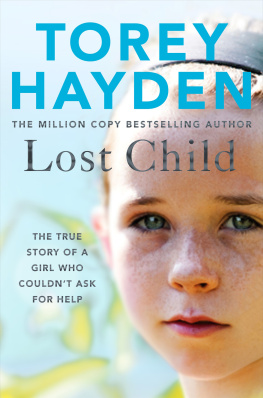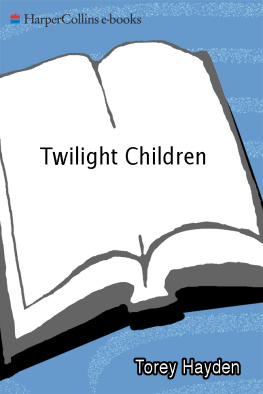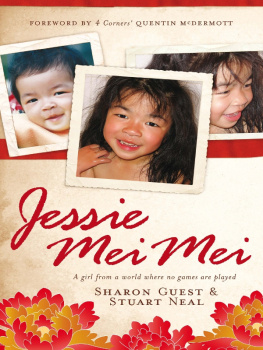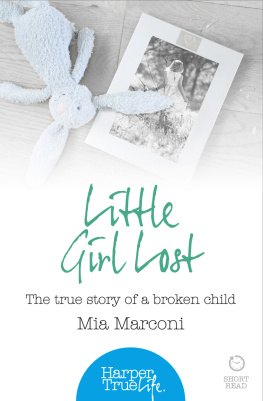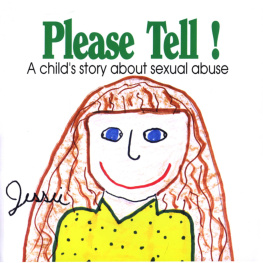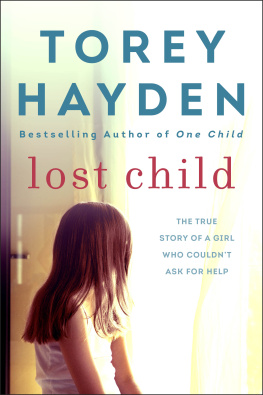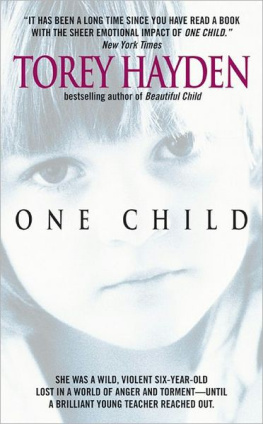
First published 2019 by Bluebird
an imprint of Pan Macmillan
20 New Wharf Road, London N1 9 RR
Associated companies throughout the world
www.panmacmillan.com
ISBN978-1-5098-6449-2
Copyright Torey Hayden 2019
Cover Image Gallery Stock
The right of Torey Hayden to be identified as the author of this work has been asserted by her in accordance with the Copyright, Designs and Patents Act 1988.
Certain details in this story, including names, places and dates, have been changed to protect the familys privacy
All rights reserved. No part of this publication may be reproduced, stored in a retrieval system, or transmitted, in any form, or by any means (electronic, mechanical, photocopying, recording or otherwise) without the prior written permission of the publisher.
Pan Macmillan does not have any control over, or any responsibility for, any author or third-party websites referred to in or on this book.
You may not copy, store, distribute, transmit, reproduce or otherwise make available this publication (or any part of it) in any form, or by any means (electronic, digital, optical, mechanical, photocopying, recording or otherwise), without the prior written permission of the publisher. Any person who does any unauthorized act in relation to this publication may be liable to criminal prosecution and civil claims for damages.
A CIP catalogue record for this book is available from the British Library.
This book is sold subject to the condition that it shall not, by way of trade or otherwise, be lent, hired out, or otherwise circulated without the publishers prior consent in any form of binding or cover other than that in which it is published and without a similar condition including this condition being imposed on the subsequent purchaser.
Visit www.panmacmillan.com to read more about all our books and to buy them. You will also find features, author interviews and news of any author events, and you can sign up for e-newsletters so that youre always first to hear about our new releases.
PART I

chapter one
In March I saw the first skylark. Not the bird, of course. On our high, windswept moors, it was much too early in the year for skylarks. This one had been drawn on a sheet of A4 paper, the ordinary kind you put in printers, and at first glance I missed the bird altogether. Meleri reached across to point to the very bottom right-hand corner. Putting on my reading glasses, I held the paper up to the car window to see a drawing that was not much bigger than my thumbnail. The weather was being typically Welsh that day, heavily overcast and mizzling too heavy to be mist, too light to be drizzle making the back seat of the car as dim as a disused chapel. On the page, the tiny bird crouched midst blades of prickly looking grass, its eyes bright, its expression shrewd, as if it knew something I didnt. Its plumage was highly coloured, more that of a macaw than a skylark. Minuscule musical notes rose up along the right-hand edge of the paper to indicate its song.
Dont you think that shows talent? Meleri asked. Shes only nine.
Whats her name again?
Jessie. Jessie Williams.
The tiny details of the drawing, so precise and intricate, mesmerized me.
Meleri opened the elasticated portfolio file resting on her knee and took out three more drawings and handed them to me. Two were done in felt-tip pen like the one I already held. The other was in pencil, the lines so pale and spidery that I could hardly make them out in the dim light. The same small bird locked eyes with me in each of them.
I like that she does them, Meleri said. They seem cheerful to me. As if Jessie still has hope.
I had met Meleri Thomas the first time a number of years earlier. It was in Cardiff, in the green room of a TV studio for the Welsh-speaking channel S4C, where we were both appearing on the morning breakfast show. I was there to promote one of my books, and she was taking part in a panel discussion about childrens rights. Meleri caught my attention immediately, because chances are she would have caught anyones attention. Her features were bold, attractive, almost Italianate large dark eyes and long, dark hair and she was dressed in a figure-hugging knit dress in a startling shade of emerald green. These aspects would have been striking enough on their own, had there not also been the fact that Meleri looked remarkably similar to popular TV chef Nigella Lawson. For just a moment I thought thats who it was and was curious why she would appear on a Welsh-speaking panel about childrens rights.
Green rooms always have an edgy atmosphere. Almost everyone waiting to go before the television cameras feels anxious for one reason or another, and as a consequence, even if you dont know each other, its common for people sitting together in a green room to make small talk as a distraction from nerves. This was challenging for me on this particular occasion, because everyone was speaking Welsh. I had only newly learned the language and was not quite fluent. More to the point, my American tongue still did not always take kindly to Welsh pronunciations. Subsequently, my only real memory of that occasion was the clanger I dropped. The weather always being a good topic for small talk, Id thought to remark on how much I was enjoying the crisp frosty days we were having. In the unanticipated hilarity that followed, I discovered the Welsh word for frost is pronounced remarkably similarly to the Welsh word for sex.
When Meleri and I met again, it was at a small conference for social workers and other youth support workers, once again in Cardiff. I recognized her flowing black hair and glamorous clothes immediately. We laughed at the memory of my embarrassing blooper, and I was forced to admit that my Welsh was even worse these days than it had been then, as Id moved to a new area where the dialect was much different. While I still read the language reasonably well, Id pretty much stopped speaking it.
Thats my area, Meleri said, as I was explaining this. Thats where I live! And then, Oh, if youre so close, please, you must come out to Glan Morfa. I have so many children Id love you to see.
It took two more years before I found myself being driven along a largely urbanized beachfront that segued from one coastal town to the next on the way to the childrens group home, Glan Morfa.
The whole area was run down, from the derelict industrial port built to serve now-disused quarries to the dreary pleasure beach with its broken roller coaster and shuttered kiosks. Then came the endless miles of holiday parks, row after row of faded caravans tinged with rust, all empty in the off season.
The car turned down a long single lane between two of these caravan parks. The road was badly potholed, so we slowed to a crawl. Indeed, it was such a bumpy ride we couldnt help but laugh in the back seat because we were so jostled, but then through a small grove of scraggy trees deformed by the sea wind, a long, low building appeared. Its stripped back, brutalist architecture hinted at a 1960s construction date. The white paint around the windows was peeling. The pebbledash walls were the colour of porridge. Meleri sensed my dismay at such bleak surroundings and said, Were hoping the council can afford to paint this year, although I think they are going to spend the money on repairing the road.

